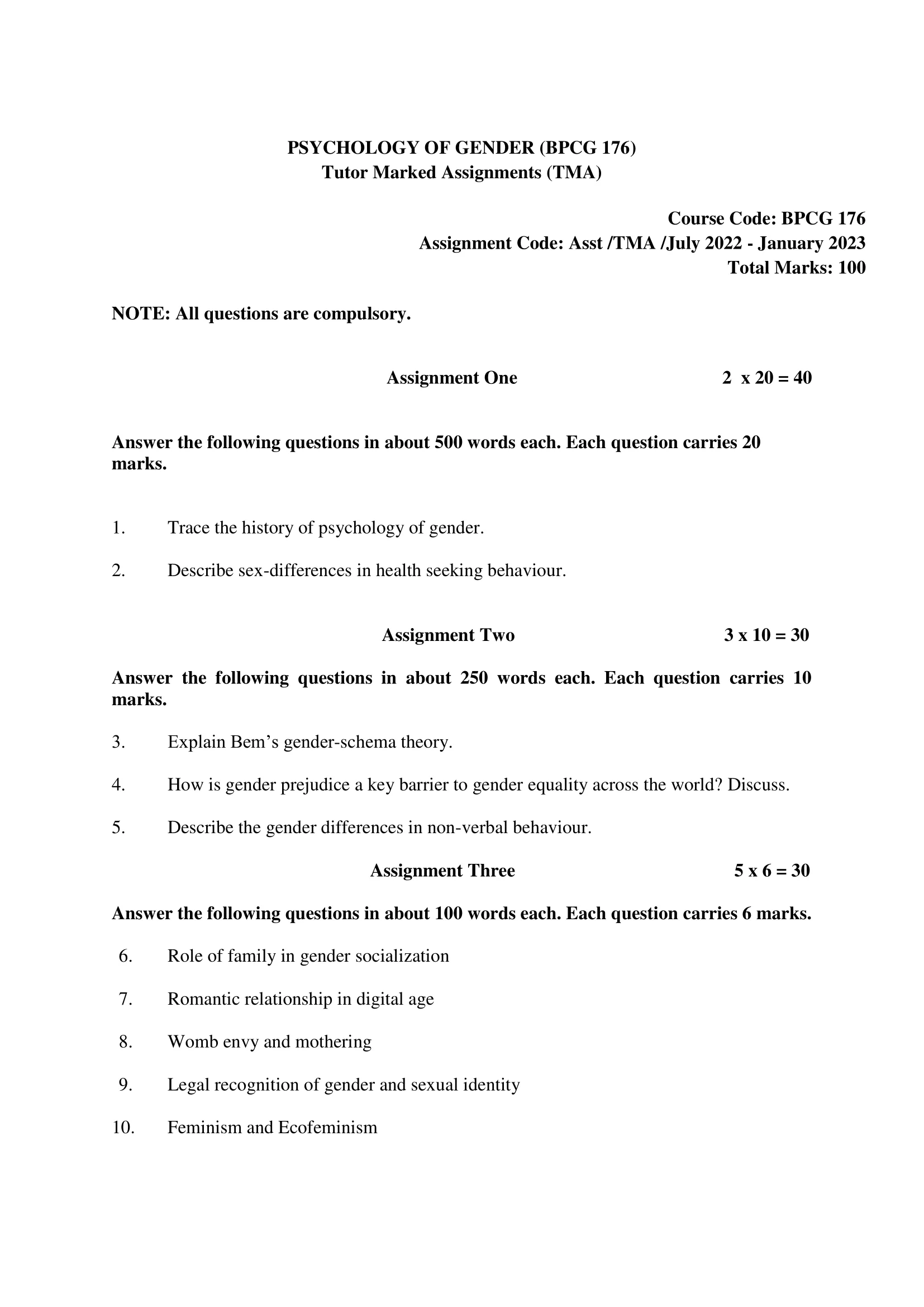Contents
- 1 Assignment One
- 2 Answer the following questions in about 500 words each. Each question carries 20 marks.
- 3 1. Trace the history of psychology of gender.
- 4 2. Describe sex-differences in health seeking behaviour.
- 5 Assignment Two
- 6 Answer the following questions in about 250 words each. Each question carries 10 marks.
- 7 3. Explain Bem’s gender-schema theory.
- 8 4. How is gender prejudice a key barrier to gender equality across the world? Discuss.
- 9 5. Describe the gender differences in non-verbal behaviour.
- 10 Assignment Three
- 11 Answer the following questions in about 100 words each. Each question carries 6 marks.
- 12 6. Role of family in gender socialization
- 13 7. Romantic relationship in digital age
- 14 8. Womb envy and mothering
- 15 9. Legal recognition of gender and sexual identity
- 16 10. Feminism and Ecofeminism

| Title | IGNOU-BPCG 176 Solved Assignment 2022-2023 (PSYCHOLOGY OF GENDER) |
| University | IGNOU |
| Degree | Bachelor Degree Programme |
| Course Code | BPCG 176 |
| Course Name | PSYCHOLOGY OF GENDER |
| Programme Name | Bachelor of Arts (General) |
| Programme Code | BAG |
| Total Marks | 100 |
| Year | 2022-2023 |
| Language | English |
| Assignment Code | Asst /TMA /July 2022 – January 2023 |
| Last Date for Submission of Assignment: | For June Examination: 31st March For December Examination: 30th September |

Assignment One
Answer the following questions in about 500 words each. Each question carries 20 marks.
1. Trace the history of psychology of gender.
Ans: The study of gender psychology has a long and varied history, tracing back to ancient civilizations and continuing to evolve to the present day.
In ancient Greece, philosophers such as Aristotle and Plato debated the nature of gender and the differences between men and women. Aristotle believed that women were intellectually inferior to men and that their role in society should be limited to the home and childbearing.
During the medieval period, the dominant religious beliefs influenced the understanding of gender roles. Women were seen as weaker and less capable than men, and their roles were defined by the Catholic Church.
In the 19th century, the field of psychology emerged as a discipline in its own right, and with it came new ideas about gender. The work of early psychologists such as Wilhelm Wundt and William James focused on individual differences and the ways in which individuals are shaped by their environment.
It was not until the 20th century that the study of gender and psychology began to take on a more systematic and scientific approach. Psychologists such as Sigmund Freud and Erik Erikson developed theories about gender identity and the ways in which early childhood experiences influence the development of gender roles.
In the mid-20th century, researchers such as psychologist Simone de Beauvoir and anthropologist Margaret Mead challenged traditional views of gender, arguing that gender roles were not biologically determined but were instead shaped by cultural and social factors. This idea of social constructionism was a major turning point in the field of gender psychology and helped to lay the foundation for modern approaches to the study of gender.
In the latter half of the 20th century, feminists such as Betty Friedan and Gloria Steinem led the feminist movement, pushing for equal rights and opportunities for women. This political activism had a profound impact on the field of gender psychology, leading to increased attention to issues such as gender-based discrimination, sexual harassment, and the impact of gender on mental health.
Today, the field of gender psychology is incredibly diverse and covers a wide range of topics, including gender identity, gender roles, gender stereotypes, gender-based violence, and the ways in which gender intersects with other aspects of identity such as race, ethnicity, and sexual orientation. In addition, advances in neuroscience have helped to shed light on the biological basis of gender and have led to a greater understanding of the complex interplay between nature and nurture in the development of gender identity.
2. Describe sex-differences in health seeking behaviour.
Ans: Sex differences in health-seeking behavior refer to the ways in which men and women approach and respond to their health needs, including the factors that influence their decisions to seek care, their perceptions of health and illness, and their preferred sources of health information and treatment.
Research has consistently shown that women are more likely than men to seek health care and to have regular check-ups with their doctor. This is often attributed to women’s greater health awareness and their role as primary caregivers for their families. Women are also more likely to seek care for mental health problems and to use preventative health services, such as screening tests and immunizations.
In contrast, men are less likely to seek health care, especially for preventive services and mental health issues. They are more likely to seek care for physical symptoms, but often delay seeking care until their condition becomes more serious. This can result in a poorer prognosis and a higher risk of complications.
Socio-cultural and economic factors can also play a role in health-seeking behavior. For example, women who experience gender-based violence or who have limited access to health care may be less likely to seek care, while men who prioritize work and personal responsibilities may delay seeking care until their health is severely compromised.
Moreover, there is evidence that sex differences in health-seeking behavior are influenced by gender stereotypes and societal expectations. For example, men may be less likely to seek care for mental health problems because they are taught to be stoic and self-reliant, while women may be more likely to seek care because they are socialized to be nurturing and care-giving.
In some cases, sex differences in health-seeking behavior can result in disparities in health outcomes. For example, women are more likely to be diagnosed with chronic conditions such as heart disease, but less likely to receive aggressive treatment or be referred for specialized care.
Assignment Two
Answer the following questions in about 250 words each. Each question carries 10 marks.
3. Explain Bem’s gender-schema theory.
Ans: Bem’s gender-schema theory proposes that individuals internalize cultural gender beliefs, known as schemas, and use them to interpret and organize their experiences and behaviors. According to Bem, gender schemas begin to develop in early childhood and are shaped by the cultural messages a person receives about gender roles, attitudes, and behaviors. This internalized schema then influences how a person views themselves, as well as how they behave and interact with others.
For example, a child who has learned that “girls play with dolls” may develop a gender schema that associates femininity with nurturing and domesticity. As this child grows and interacts with the world, they will use this schema to understand and categorize their experiences, and may also adjust their behavior to align with the expectations associated with their gender.
Bem’s theory also suggests that gender schemas are not static but can evolve and change over time as a person continues to learn and interpret cultural messages. Moreover, the theory proposes that individuals may have multiple gender schemas that they use in different situations, and that these schemas can interact and influence one another.
This theory has important implications for understanding gender development, gender identity, and gender-based inequalities. Bem’s work highlights the role of cultural expectations in shaping individual experiences and behaviors, and underscores the importance of critically examining and challenging gender schemas in order to promote gender equality.
Overall, Bem’s gender-schema theory provides a valuable framework for understanding the ways in which individuals internalize cultural beliefs about gender and use these beliefs to make sense of their experiences.
4. How is gender prejudice a key barrier to gender equality across the world? Discuss.
Ans: Non-verbal behavior refers to communication that occurs without the use of words, including gestures, facial expressions, body posture, and tone of voice. Gender differences in non-verbal behavior can be significant and can contribute to misunderstandings in both social and professional settings.
Studies have shown that men and women often use different non-verbal cues to express their thoughts and feelings. For example, women tend to use more eye contact, smiling, and nodding to show agreement or interest in a conversation. Men, on the other hand, may use larger gestures and more assertive postures to convey power and dominance.
In terms of emotional expressions, women tend to be more expressive with their faces, using gestures like frowning, crying, and smiling to show their feelings. Men are often expected to keep their emotions under control and are less likely to show emotional displays in public.
When it comes to personal space, women generally prefer more intimate distances during conversations, while men tend to stand farther apart from each other. This difference in personal space can lead to misunderstandings in cross-gender interactions.
5. Describe the gender differences in non-verbal behaviour.
Ans: Gender differences in non-verbal behavior can have a significant impact on communication and can lead to misunderstandings between individuals of different genders. These differences stem from social and cultural norms that prescribe different behaviors for men and women.
One of the most significant differences in non-verbal behavior is in the use of eye contact. Women tend to use more eye contact as a way of establishing rapport and building trust, while men often use eye contact to assert dominance and authority. Women also tend to use more gestures, such as nodding and smiling, to show interest and agreement, while men use larger gestures to emphasize their points and convey confidence.
In terms of body language, women tend to use more open and welcoming postures, such as leaning towards the person they are speaking with and keeping their arms uncrossed. Men, on the other hand, use more assertive and dominant postures, such as standing tall with their arms crossed. These differences in body language can have an impact on how people perceive each other and can lead to misunderstandings.
When it comes to emotional expressions, women tend to be more expressive with their faces, using gestures like frowning, crying, and smiling to show their feelings. Men are often expected to keep their emotions under control and are less likely to show emotional displays in public. This can lead to misunderstandings when women interpret a man’s lack of emotional expression as a lack of empathy or interest.
Assignment Three
Answer the following questions in about 100 words each. Each question carries 6 marks.
Ans: The family is one of the most important social institutions for gender socialization, shaping children’s beliefs, attitudes, and behaviors regarding gender roles and expectations. Family members, including parents, siblings, and extended family, serve as primary models and teachers of gender-related norms and behaviors. Family interactions and relationships can reinforce gender stereotypes, reinforce gender-typed activities and interests, and provide children with a sense of their own gender identity. Family values, attitudes, and expectations can also influence children’s choices and decisions, shaping their future career paths, relationship patterns, and life goals. Therefore, the family plays a crucial role in shaping children’s gender identity and understanding of gender roles and expectations.
7. Romantic relationship in digital age
Ans: The digital age has brought about significant changes in the way individuals form and maintain romantic relationships. With the widespread use of technology, such as dating apps, social media, and instant messaging, individuals now have more opportunities to connect with potential partners and to maintain long-distance relationships. However, this new mode of communication has also brought about challenges, such as the potential for misunderstandings and conflicts, increased competition and comparison, and reduced face-to-face communication.
The role of technology in romantic relationships has been a topic of much discussion and debate. While some argue that technology has made dating and relationships easier and more accessible, others suggest that it has led to a decline in genuine connections and emotional intimacy. Overall, the impact of technology on romantic relationships is complex and multi-faceted, requiring a nuanced understanding of the benefits and challenges it presents.
8. Womb envy and mothering
Ans: Womb envy refers to the psychological concept of men feeling envious or resentful of women’s ability to give birth and bear children. It is believed that this envy is rooted in the cultural and historical emphasis on motherhood as a central aspect of femininity and womanhood, and the belief that motherhood represents a source of power and superiority for women.
Mothering refers to the social and cultural practices surrounding the care and nurturing of children, including both biological and non-biological parenting. Mothering is often viewed as a gendered practice, with women being expected to take on the primary responsibility for childcare and domestic labor. This gendered division of labor can contribute to feelings of womb envy among men and can also lead to negative stereotypes and expectations of mothers and motherhood.
Overall, the concepts of womb envy and mothering are closely connected and reflect larger social, cultural, and historical beliefs about gender roles and parenting. Understanding these concepts can help us to better understand and challenge the ways in which gender and parenting are interconnected and can shape our beliefs and attitudes about femininity, masculinity, and caregiving.
9. Legal recognition of gender and sexual identity
Ans: Legal recognition of gender and sexual identity refers to the laws and policies that acknowledge and protect an individual’s gender identity and sexual orientation. This includes laws that prohibit discrimination based on gender identity and sexual orientation in employment, housing, and other areas. Some countries have also recognized same-sex marriage, allowing LGBTQ individuals to marry and access the same legal benefits and protections as opposite-sex couples. The fight for legal recognition of gender and sexual identity is an ongoing effort, with some countries lagging behind in granting equal rights to their LGBTQ citizens. It is crucial for governments to guarantee legal protection for all individuals, regardless of their gender identity or sexual orientation, to ensure a fair and equal society for all.
10. Feminism and Ecofeminism
Ans: Feminism is a social, political, and cultural movement that aims to advance gender equality and challenge patriarchal norms. Ecofeminism is a branch of feminism that links the oppression of women to the exploitation and degradation of the environment. It argues that these issues are interconnected and that addressing one requires addressing the other. Ecofeminists advocate for a more sustainable and equitable world, where the needs of both women and the planet are prioritized. They challenge the dominant systems of power and strive to create a world where all beings can flourish. By combining feminist and environmental activism, ecofeminism offers a holistic approach to creating a better world.
How to Download BPCG 176 Solved Assignment?
You can download it from the www.edukar.in, they have a big database for all the IGNOU solved assignments.
Is the BPCG 176 Solved Assignment Free?
Yes this is absolutely free to download the solved assignment from www.edukar.in
What is the last submission date for BPCG 176 Assignment?
For June Examination: 31st March, For December Examination: 30th September















![[Solved Assignment] BPCS 188-APPLICATIONS OF SOCIAL PSYCHOLOGY (IGNOU-BAG) 2022-2023 BPCS 188-APPLICATIONS OF SOCIAL PSYCHOLOGY IGNOU BAG Solved Assignment 2022-2023](https://edukar.in/wp-content/uploads/2023/01/BPCS-188-APPLICATIONS-OF-SOCIAL-PSYCHOLOGY-IGNOU-BAG-Solved-Assignment-2022-2023-1024x640.webp)
